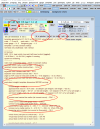Dog Star
Western Thunderer
Whilst my interest is GWR PW of the Edwardian period (circa 1900-1910) I think that my question might be of a more generic nature. I am building loose-heel turnouts, typically 1:7 crossing and 12' switches, in 7mm scale and using Templot templates that have been drawn for me (thank you Chris @ChrisBr and Peter @Spike ) because my computer abilities just fail to connect with the Templot computer program.
So I get given a template of a turnout with both leads of similar flexure. I shall presume that as Templot has "drawn" the curve of the rails then Templot probably has knowledge of the radius of the closures rails... and might be persuaded to display such data on the laptop screen.
Referring to the GWSG Switch and Crossing Practice publication, appendix 3, table 4, page 142, there is a table of prototype data with a column headed "Turnout Radius" (lettered "R" in the drawing at the top of page 142). What I wish to know is how to ask Templot to display Templot's value for a 7mm equivalent of "R" as used in curved turnout templates that are prepared by Chris and Peter.
thank you, Graham
So I get given a template of a turnout with both leads of similar flexure. I shall presume that as Templot has "drawn" the curve of the rails then Templot probably has knowledge of the radius of the closures rails... and might be persuaded to display such data on the laptop screen.
Referring to the GWSG Switch and Crossing Practice publication, appendix 3, table 4, page 142, there is a table of prototype data with a column headed "Turnout Radius" (lettered "R" in the drawing at the top of page 142). What I wish to know is how to ask Templot to display Templot's value for a 7mm equivalent of "R" as used in curved turnout templates that are prepared by Chris and Peter.
thank you, Graham



